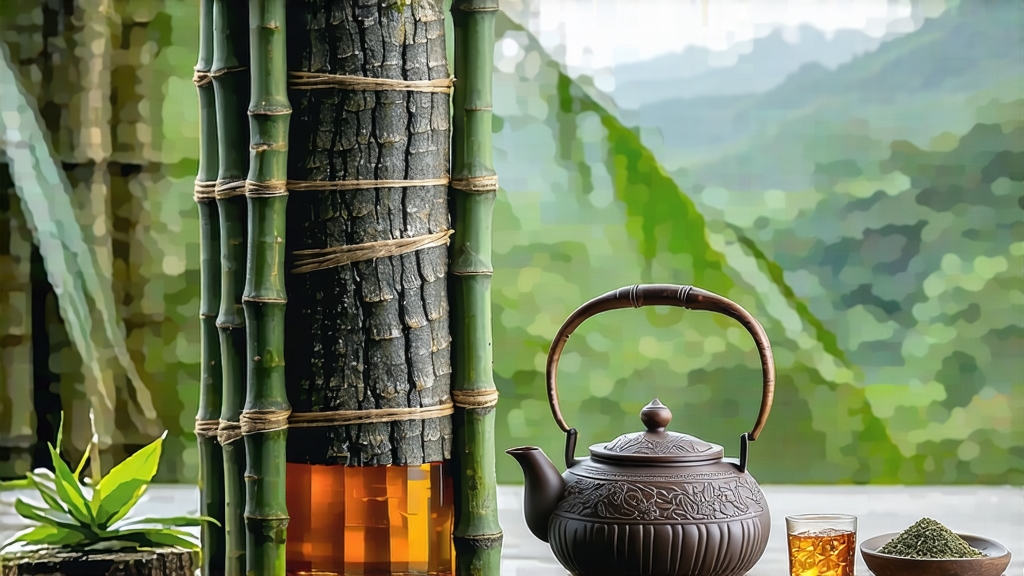
If you have ever walked the narrow mountain roads of Anhua county in midsummer, you have probably met the scent before you saw the tea: resinous pine smoke drifting through humid air, followed by the sweet, almost date-like aroma of slowly fermenting leaves. That scent is the signature of Qianliang Cha—literally “Thousand-Tael Tea”—a giant bamboo-sheathed log of dark tea that can weigh more than 36 kilograms and stands taller than most children. For three centuries it was carried out of Hunan on human shoulders and bamboo rafts, financing imperial armies and nourishing caravans along the Ancient Tea Road to Mongolia and Russia. Today the same log is split open in boutique tearooms from Paris to Vancouver, revealing a mellow, cocoa-dark liquor that still carries the mountain mist and pine smoke of its birthplace.
-
From Tribute to Trade: a Brief History
Qianliang Cha first appears in county gazettes of the Daoguang era (1821-1850), when the imperial court granted Anhua county a monopoly on “border tea” destined for the northwestern horse markets. Merchants needed a package that was compact, theft-proof, and sturdy enough for a three-month trek. They steamed the fermented leaves until pliable, packed them into long bamboo cylinders lined with palm leaf, then compressed the bundle with wooden levers until it resembled an iron-hard log. One log weighed exactly 1,000 old Chinese taels (about 36.25 kg), hence the name. Wrapped in bamboo and bound with rattan, the logs could be rolled, floated, or strapped to mules without bruising the tea inside. By the 1860s the port of Hankou on the Yangtze had become the world’s largest dark-tea entrepôt, and Qianliang Cha was its most valuable currency, exchanged for Mongolian horses, Russian furs, and Tibetan medicinal herbs. -
Terroir and Leaf: What Goes into the Log
Only three townships—Dongping, Jiangnan, and Xiaoyan—produce leaves considered authentic for Qianliang Cha. The mountains rise sharply above the Zi River, creating a daily fog belt that filters sunlight and slows photosynthesis, concentrating amino acids. Bushes here are almost entirely the local “Yun-Tai” cultivar, a late-sprouting variety whose thick, waxy leaves tolerate repeated misting without molding. Picking occurs from late April to early May, when two leaves and a bud are still tinged purple at the edge, a sign of abundant anthocyanins that later convert into the tea’s characteristic orchid fragrance. -
Crafting a Giant: the Eight-Stage Process
a. Withering: Fresh leaves are spread on bamboo racks in drafty lofts for 6–8 hours, losing about 30 % moisture and developing a faint grassy note.
b. Fixing: A 280 °C wok roast lasting 90 seconds deactivates enzymes, but the operator keeps a handful of pine needles in the wok; the resin coats the leaf surface, forming the first layer of smoke aroma.
c. Rolling: The hot leaves are immediately rolled under mechanical pressure for 25 minutes, rupturing cells so that oxidative juices bleed to the surface.
d. Pile-fermentation: Unique to dark teas, this step sees the leaves heaped 70 cm high in a humid room for 18–24 hours. A thermophilic microbial consortium dominated by Aspergillus niger and Bacillus subtilis raises the pile temperature to 55 °C, turning the leaves from green to chestnut and generating a sweet, winey scent.
e. Sun-drying: The fermented leaves are spread under direct mountain sun for one full day, locking in color and reducing moisture to 10 %.
f. Secondary firing: Small pine logs are burned in a semi-enclosed pit; the leaves, now called maocha, are dried on racks 1.5 m above the flame for three hours, absorbing smoke without scorching.
g. Steaming and compression: Exactly 6.25 kg of maocha are steamed for 30 seconds to regain flexibility, then rammed into a bamboo cylinder lined with fresh palm leaf. Two workers stand on a lever beam, jumping in rhythm to compress the tea to half its loose volume. The